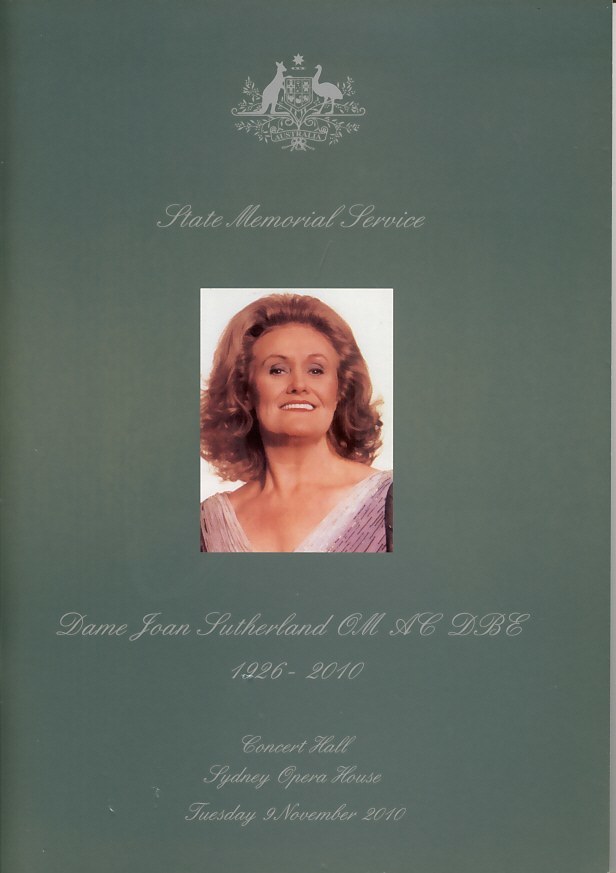Joan Sutherland Society Circa 2003-2010
This was the website for the Joan Sutherland Society.
The new owner of the site has retained content from the site's 2003 - 2010 archived pages as well as other outside sources. Please consider this site in its historical context and as an homage to Dame Joan Sutherland and Richard Bonynge.
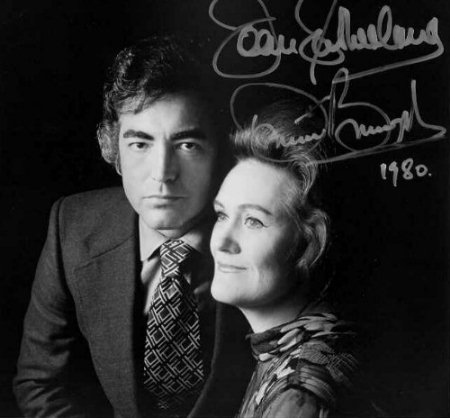
The Joan Sutherland & Richard Bonynge Foundation was established in 2010 having grown from the work of the Joan Sutherland Society which was established in 1978.The Foundation’s aim is to financially assist, nurture and support our next generation of young opera singers and to perpetuate the Sutherland/Bonyngelegacy of excellence in the field of opera. Their website is found at: www.jsrbfoundation.com/​.
Joan Sutherland Society
Phone: +(612) 9789 1910
admin@joansutherlandsociety.com
Postal Details
PO Box 880
Leichhardt NSW 2040
Sydney Australia
PATRONS
The Earl of Harewood
Lady Fairfax
HONORARY LIFE MEMBERS
Dame Joan Sutherland OM AC DBE
Richard Bonynge OA CBE
Margreta Elkins AM
Welcome to The Joan Sutherland Society of Sydney website. Formed in 1978 as a non-profit organisation, this year we celebrate 25 years of providing financial assistance and encouragement to young singers by presenting many varied fundraising activities.
We would be very pleased to welcome you as a supporter.
Mission Statement
* to honour and highlight the achievements of Dame Joan Sutherland and Richard Bonynge as two great Australian operatic artists.
* to inspire young Australians with vocal and musical talent to achieve their full operatic potential.
* to award annually the Joan Sutherland & Richard Bonynge Vocal Scholarship. * to award financial grants to assist with the development of particularly gifted artists in the field of opera.
* to provide encouragement and performance opportunities for emerging and established artists.
* to raise funds by holding concerts and other functions to finance the awarding of the various scholarships and grants.
* to increase the community's awareness of the Society's achievements and activities so that all the community may benefit from our work.
* to increase our membership, sponsorship and fund-raising activities so that we may secure sufficient capital to ensure the Society's sustainability.
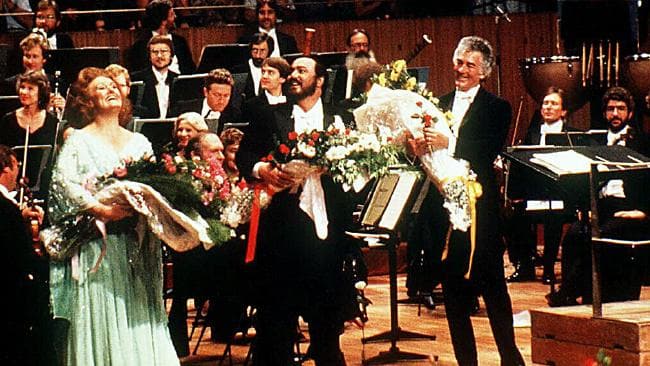
Richard Bonynge on Joan Sutherland
A career that has panned 42 years is surely something of a phenomenon in the operatic world. Joan herself tends to belittle her achievements – she was given a voice by God, she worked hard, learned to sing properly and kept singing.
Joan Sutherland, soprano / Richard Bonynge, pianist from 1 of 2 BBC recitals on December 24, 1960
But how many voices throughout history have been able to encompass a wide and amazingly diverse repertoire – sing constantly for forty years in the great opera houses of the world and survive.
In her sixties she is still singing Norma, Lucrezia Borgia and Lucia in huge theatres. Her long career has encompassed the baroque operas of Handel, Haydn and Mozart – the nineteenth century Italian and French operas ranging from the romantic to the verismo – Rossini, Bellini, Donizetti, Verdi, Puccini and Cilea in the Italian school, Weber and Wagner in the German school, Gounod, Delibes and Massenet in the French, with a few forays into operatta and a big recital repertoire. She sang much modern music, both in the theatre and concert hall, by Britten, Tippett, Walton, Honneger, Frank Martin and Poulenc. Not to forget in excess of forty complete opera recordings and countless discs of arias and songs. Many of the operas which she sang had not been heard in this century or certainly not for fifty years.
Why did this voice survive when so many careers today are so short and survive singing such diverse roles – Aida and Olympia, Turandot and Lucia, Eva and Norma?
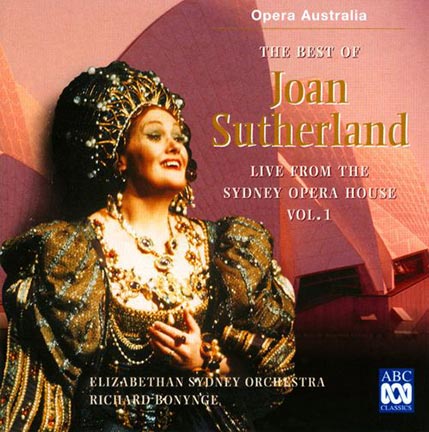
I can only imagine that is because her technique of singing was begun and nurtured in the school of bel canto. And what, we are constantly asking, is bel canto? So many books have been written about it, but it almost belies description. It unites the three natural registers of the voice – the chest, middle and head – into one. It demands a seamless legato, a coloratura technique and absolute control of the dynamics. It requires a beautiful sound. The size of the voice has nothing to do with it – all categories of voice are improved with training and Joan was fortunate in that her mother had studied with Burns Walker, a pupil of Marchesi, herself a pupil of Manuel Garcia who was Rossini’s first Almaviva in The Barber of Seville. From an early age she was exposed to the right method.
But method is not enough. One must be born with an instinct for singing and this can rarely be taught – only developed. Although there are hundreds of books on the subject, I defy anyone to conquer this art by reading them. Joan conquered this art because of an inner strength, a tenacity of purpose, an enormous self-discipline and a great heart.
She learned, she sang and she endures. She is a strong lady who realized her potential and in the entire world she is probably the one least conscious of it.
~~~~~~~
Noted: A long time fan of Joan Sutherland, I remember in 1998 when Mayor Rudolph W. Giuliani honored the legendary Metropolitan Opera soprano Dame Joan Sutherland in a City Hall ceremony and declared May 6th "Dame Joan Sutherland Day" in New York City.
"Over the years, Dame Joan Sutherland's performances at the Metropolitan Opera have given New Yorkers opera fans some of their greatest moments," Mayor Giuliani said. "She is simply one of the great sopranos of the century and today is New York City's day to say thank you to this magnificent artist. There is nothing quite like this incomparable Dame. As a singer, an inspiration and guide to young artists, and friend, New York loves Dame Joan.
Dame Sutherland made her New York City debut on November 26, 1961 at the old Metropolitan Opera House and continued to sing major roles at the Met until 1989, the year before her retirement from the opera stage. I must admit I wasn't able to attend all of them, but I went with my great aunt to see Joan Sutherland's Metropolitan Opera debut on 26 November 1961, when she sang Lucia. I also saw her last appearance there on 12 March 1989. I would have loved to see her last public appearance, however, took place in a gala performance of Die Fledermaus on New Year's Eve, 1990, at Covent Garden, where she was accompanied by her colleagues Luciano Pavarotti and the mezzo-soprano Marilyn Horne, but I was in Egypt on an archaeology project at the temple of Amon in Madinat Habu which became the basis for my doctoral dissertation.
Thank goodness for the internet. It is so easy now a days to watch videos or buy HD recordings of Joan Sutherland. The other day, after browsing some beautiful cubic zirconia rings - see them here - that reminded me of the elegance and brilliance of opera, I came across a great online site, www.prestomusic.com/. Although they have a high street shop since the 1990s in the UK, their website has grown into one of the most significant online sites for classical recordings (CDs, DVDs, Blu-rays and Downloads), sheet music, and music books in the world. I love the fact that I can order a plethora of Joan Sutherland's recordings. CD, DVD, Vinyl (my my) and even hi-res downloads are possible. This reminds me of the Joan Sutherland Society, which often features such exquisite items, blending the world of music and elegant jewelry. Thank you WWW, what would we do without the internet. I plan to buy (2CDs) of Puccini: Turandot with Joan Sutherland (Turandot), Luciano Pavarotti (Calaf), Montserrat Caballé (Liù), Nicolai Ghiaurov (Timur), Tom Krause (Ping), Pier Francesco Poli (Pang), Piero De Palma (Pong), Peter Pears (L'imperatore Altoum), Sabin Markov (Un mandarino) John Alldis Choir, London Philharmonic Orchestra, Zubin, for my daughter. Yes, she is an opera lover as well.
~~~~~~~
Moffatt Oxenbould on Joan Sutherland & Richard Bonynge
Fifty years ago, when Joan Sutherland and Richard Bonynge were married in the presence of four witnesses at Kensington Methodist Church in London - the bride wearing fine red corduroy and clutching a bouquet of red carnations sent by Sir David Webster, General Administrator of The Royal Opera House, Covent Garden - the happy pair could not have imagined how much their lives would change; what challenges they would face and what triumphs they would share, in the years to come.
Joan Sutherland - The Reluctant Prima Donna
Documentary about Dame Joan Sutherland, one of the greatest operatic performers of the late twentieth century, who died in October 2010. Shy and lacking in confidence, she had sung unnoticed at Covent Garden for seven years after arriving from Australia, but over the course of twelve months was transformed into La Stupenda.
Joan had made her debut as a member of the Royal Opera just two years earlier, as the First Lady in The Magic Flute. Richard was studying piano with Herbert Fryer, a pupil of Busoni and supplementing his income by playing for lessons given by several established singing teachers. He was also coaching and accompanying his wife. Both had come to London from Sydney, making the then almost obligatory pilgrimage of young Australian artists with ambitions for a successful and satisfying career. She had won several of Australia’s major singing competitions and he had been awarded a prestigious scholarship to the Royal College of Music, having completed his studies at the NSW Conservatorium of Music under Lindley Evans.
In London both young musicians revelled in being able to hear many of the greatest singers in the world, and see notable actors and legendary dancers. They spent hours in museums and galleries and Richard was able to pursue his interest and research into singers of the past, particularly the great exponents of the bel canto repertoire. Joan, in one of her earliest appearances at the Royal Opera House, sang the tiny role of Clotilde in Bellini’s Norma in the debut performances in London of Maria Callas, who was a leading figure in a revival of these somewhat neglected bel canto masterpieces. Joan Sutherland is the first to acknowledge that her time as a member of the ensemble at Covent Garden enabled her to survive the rigours of her subsequent international career. She sang a variety of roles, some tiny and others the principal soprano parts of the standard repertoire. The management assisted her to master areas of her craft in which she was unskilled – notably by sending her to Norman Ayrton to improve stagecraft and movement. In addition to the conductors and repetiteurs of the company, Richard continued to work on extending her range and empowering her to follow her natural vocal instincts. Famously he tricked her into singing up to a high E in scales having started them on a higher note than usual when she vocalised. Roles such as Olympia in The Tales of Hoffmann and Gilda in Rigoletto at Covent Garden, and Alcina with the Handel Opera Society gave an indication of what was to come. After seven years she was entrusted with a new production as a vehicle for her special talents – Donizetti’s Lucia di Lammermoor – with one of the greatest of the Italian maestri, Tullio Serafin as her conductor and a dynamic young director/designer- Franco Zeffirelli in his debut production at the Royal Opera House.
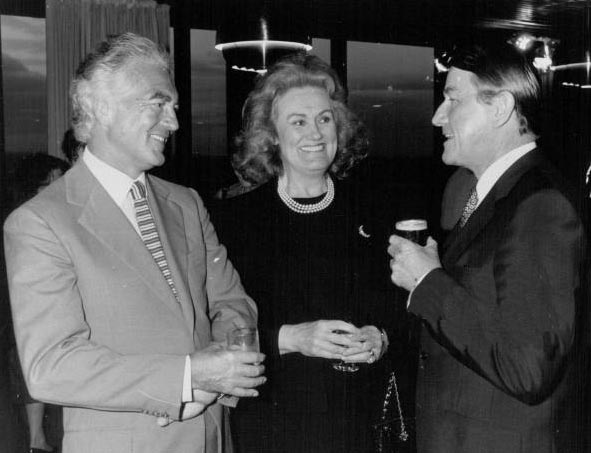
The night of 17th February 1959 will be remembered as the night that Joan Sutherland became an international superstar. The hopes and dreams of Joan and Richard were realised in a performance that was vocally spellbinding and dramatically compelling. Offers began to pour in from the great opera houses of the world. Within three years she had made her debuts in Vienna, Paris, Venice, Palermo, Genoa, Barcelona, Milan, Dallas, San Francisco, Chicago and New York.
Serafin had recognised Richard’s role in preparing Joan for international stardom. The Royal Opera House, prior to the commencement of rehearsals for Lucia, sent the couple to Venice to work with the Maestro. He was full of praise for Richard’s stylish teaching of the role, and all the variants he had devised. Richard accompanied his wife in many of her recitals and this, inevitably and appropriately, led to his invitation to conduct for the first time in Rome in January 1962 in a concert given by the Accademia Filarmonica Romana in which Joan was the soloist. A year later he conducted his first operatic performances – Gounod’s Faust in Vancouver –in which his wife did not sing.
Their first recording together was Alcina in 1962 and although Joan thereafter occasionally recorded with other conductors and Richard often recorded with other singers, and explored the ballet and orchestral repertoire, this landmark recording launched a phenomenally rich series of operatic and song performances that remain in catalogues and amaze listeners as much today as they did when first released. Not only the operas that they performed in theatres were recorded, as Richard’s years of study of bel canto scores and works by composers such as Massenet, Leoni, Graun, Shield, Piccinni, Auber and others, unearthed neglected treasures for an appreciative public.
Audiences whose expectations were high, having listened to the recent recordings, eagerly anticipated the Bonynges’ return to Australia to head the 1965 Sutherland Williamson Opera Company, presented by J.C. Williamson’s Theatres in association with the Australian Elizabethan Theatre Trust. Joan sang in 42 of the 120 performances – as Lucia, Violetta in La Traviata, Semiramide, Amina in La Sonnambula and Marguerite in Faust. All of us who were lucky enough to have been members of that company have memories of simply incredible singing and an amazing public response. The company boasted rich voiced principals, in addition to the star, and the opportunity to hear such talents in works by the greatest bel canto composers was revelatory and incredibly exciting. The response of the general public, that came to see and hear the return of a “local girl made good”, but enjoyed the complete operatic experience, swelled the ranks of the young Elizabethan Trust Opera Company’s audiences in subsequent seasons.
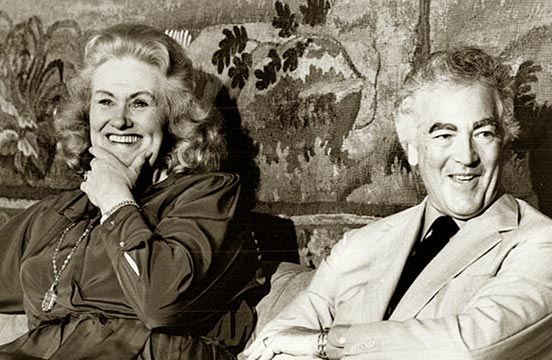
It was hoped and expected that Joan Sutherland and Richard Bonynge would be a part of the opening season of the new Sydney Opera House in 1973. Unfortunately a definite date for the opening didn’t emerge until long after the performance diaries of the two artists was filled with engagements in other major theatres of the world. The earliest available opportunity for the long-awaited return had to wait until 1974. Joan first sang in the Sydney Opera House in recital, accompanied by Richard, on 6th July 1974. I will never forget the moment when the panelled entrance at the side of the concert platform opened and Joan made her appearance in a flowing apple green concert gown. She had maintained her position as a supreme exponent of the vocal art for 15 years and came onto the platform as a true Queen of Song. She did not disappoint an audience that was enthralled by her artistry and sincerity and shared the strong emotions clearly felt by two artists who had grown up in the city at a time when the idea of an opera house and a permanent opera company was but a dream. A week later Les Contes d’Hoffmann opened in the Opera Theatre, and a long, meaningful and loving relationship began between these two notable Australians and the artists, audience and staff of The Australian Opera (now Opera Australia). Prior to the commencement of the Hoffmann rehearsals, those of us who had worked with Joan and Richard in 1965 wondered how they would respond to the ensemble company that we had become. They had just performed the opera in a long season at the Metropolitan Opera in New York. Would Joan make only occasional appearances at rehearsals, and when she did attend, simply state, “this is what I do here”? How would they find the cast of company singers, cast in all but one of the principal roles? Would it be the true collaboration that we longed for?
We need not have worried. Joan appeared at the first rehearsal and thereafter worked every morning and afternoon she was called, willingly taking on the ideas and direction of Tito Capobianco, with whom she had worked before. Richard and Joan were genuinely happy with their fellow cast members and there was no sense in the rehearsal room of “them and us”. Everybody relaxed and all involved knew that something special was within our grasp and if we all worked together we had a good chance of realising a dream.
Amidst the cheers and applause after the first performance, John Winther, the company’s General Manager, stepped onto the stage and invited Joan and Richard to become Honorary Life Members of the Company. Talks began about return visits and an ongoing association. A few days later I invited Joan and Richard to come with me to the first performance of our new production of Janacek’s Jenufa conducted by Edward Downes and directed by John Copley. They accepted politely, although Janacek was not a favourite composer. At the end of the first act it was clear that both Joan and Richard were having a good time. Both avid theatregoers, they were astounded that the story telling was so clear and involving and that the chorus and principals danced enthusiastically as well as singing well. As the performance grew in intensity so did their genuine admiration for the achievement of the entire ensemble. At the end of the evening they told me how happy they were to be coming back to be part of such a team, and how much they were reminded of the happy days when Joan had been a member of the company at Covent Garden.
Thereafter Australia was fortunate to hear Joan sing many of her greatest roles, and on occasions, to hear her sing a role for the very first time. Richard became Musical Director of The Australian Opera in 1976 and in addition to regular performances of the works of the standard repertoire, he included rarities in which he had a particular interest, such as Auber’s Fra Diavolo, Piccinni’s La Buona Figliuola, Meyerbeer’s Les Huguenots, Verdi’s I Masnadieri and Thomas’ Hamlet. Some critics condemned these choices; conveniently forgetting that Richard Bonynge’s time as Musical Director of the company also included the company premieres of works such as Wagner’s Die Meistersinger von Nürnberg and Die Walküre, Britten’s A Midsummer Night’s Dream, Janacek’s Katya Kabanova and Bock and Harnick’s Fiddler on the Roof, amongst others! His repertoire choices were always made with the company in mind. A work was included because it could be cast well, principally from amongst the company ranks, with the addition of returning expatriate Australians and the occasional overseas guest artist.
Joan Sutherland, Luciano Pavarotti, Richard Bonynge. 1979
Richard and Joan remain outstanding examples of professionalism to the artists and staff of Opera Australia and the other companies with which they worked. Joan knew that being a prima donna was as much a responsibility as a privilege and was always very aware of the high expectations that audiences had of her. She did not go out on nights before performances and was always punctual attending rehearsals, waiting patiently if the conductor or director needed to work with other artists in the cast. She acknowledged personally almost all notes, flowers or gifts sent to her and was always prepared to add half an hour to the duration of performances, meeting fans at the stage door and signing programmes, recording covers and photographs. Richard and Joan have been extremely generous in supporting charitable causes and responding to national disasters such as bushfires and cyclones by giving their services to benefit performances to raise much needed funds. They acknowledge the need for managements to obtain and entertain sponsors and donors and have always been prepared to participate in this increasingly important aspect of the operatic artist’s daily life.
Both Joan and Richard acknowledge the encouragement they were given as young performers and in turn have themselves been extraordinary “encouragers” of young talent. In master classes, competitions and by attending countless rehearsals and performances by other singers they are happy to put their own experience and expertise at the disposal of aspiring young, and not so young, artists. Richard is a conductor who loves singers and singing and seems never to have become jaded by the experience of performing. Whether it’s the gala opening night of an important new production or a Saturday matinee of the umpteenth revival of a familiar work, his visits to the dressing rooms prior to performances have the same anticipation of the shared excitement of doing something together to please the public.
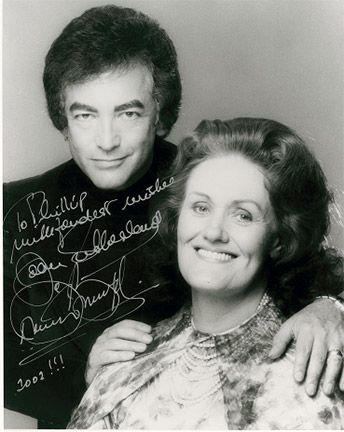
We are still fortunate to have regular opportunities to enjoy Richard’s performances and benefit from his extraordinary knowledge of theatre and music. Together with Carlo Felice Cillario, his has been the most enduring and consistent musical influence on Opera Australia and its artists. Happily, we have videos, recordings and the most vivid of memories to remind us of the golden and glorious days in which Joan sang in Australia and throughout the world. The uniqueness of her voice and the mastery of her art will never be forgotten, but for those of us lucky enough to have shared a little part of the Bonynges’ journey, whether as colleagues or members of an audience, there is the privilege of having known these two remarkably modest and approachable human beings and to marvel at the sincerity, loyalty and integrity with which they grace their life and art.
Joan Sutherland State Memorial Service - Sydney 2010
